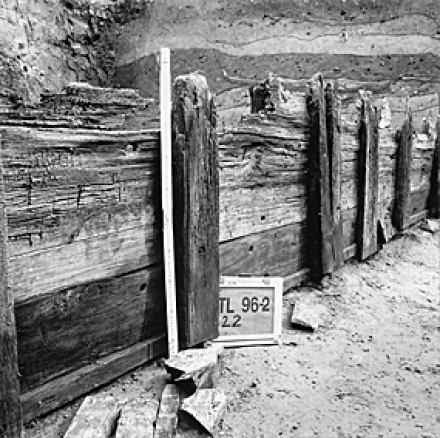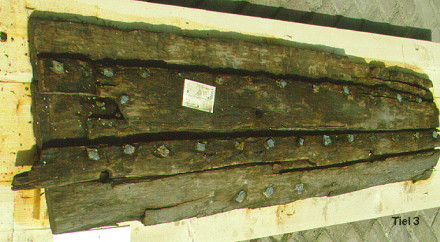History
During excavations of the medieval harbour on the river Linge in Tol-Zuid near Tiel in the Netherlands in 1996, wooden parts belonging to ships were found. They were deemed to belong to shipwrecks, one of which received the name Tiel 3. Among the others were Tiel 2 and the Tiel ship fragment of a longboat.
These pieces of wood had been reused as a revetment that was built around 1015 AD. It consists of fragments of the bottom and a part of a board. The oldest fragments come from a barge whose timber was felled after around 990 AD.

The revetment in which the wood of the Tiel 3 wreck was used was dated. The timber was felled in the winter of 1013-1014 and the spring of 1014, which shows that the ship could have been in operation for no longer than a decade.
Description
Type: Barge
These types of river barges were especially built for navigating the rivers and intended to transport heavy goods. They had a roughly rectangular floor plan and were ideally suited for sailing and maneuvering on shallow, slow-flowing rivers. The flat bottom consisted of carvel laid planks which merge into special, often l-shaped, bilge strakes. Cattle, goods and carts could be transported with the boats.
Status
Caulking
These ships were caulked with moss between the planks, covered with moss slats, also called cinder rods. These slats were made from long twigs cut along the length. In the Tiel 3 wreck, they were kept in place by special nails. These are forged iron staples that were especially made to attach the moss slats to the boards of the ship. The shape of this type of nail has evolved over the centuries. Those of the Tiel 3 ship belong to the earliest type. The method of caulking with moss, moss slats and nails was used throughout Northwestern Europe in the Middle Ages.
10th and 11th century quays made from ship parts have also been excavated in Deventer and Utrecht in the Netherlands. The two Tiel ship fragments show similarities with the Utrecht boats (see Utrecht 1) as well as with the Deventer ship parts.

References
- Navisone.
Tiel 3. - W. Brouwers, E. Jansma, M. Manders (2015).
Middeleeuwse scheepsresten in Nederland, de vroege middeleeuwen 500-1050.
Archeobrief 3.